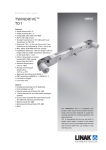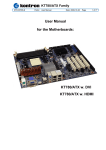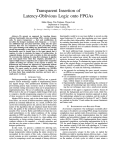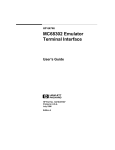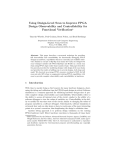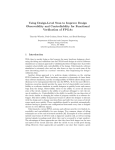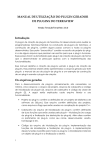Download Simulating Verilog RTL using Synopsys VCS Getting started
Transcript
Simulating Verilog RTL using Synopsys VCS 6.375 Tutorial 1 February 1, 2007 In this tutorial you will gain experience using Synopsys VCS to compile cycle-accurate executable simulators from Verilog RTL. You will also learn how to use the Synopsys Waveform viewer to trace the various signals in your design. Figure 1 illustrates the basic VCS and SMIPS assembler toolflow. VCS takes a set of Verilog files as input and produces a simulator. When we execute the simulator we need some way to observe our design so that we can measure its performance and verify that it is working correctly. There are two primary ways to observe our design: (1) we can use $display statements in our Verilog RTL to output textual trace information, or (2) we can instruct the simulator to automatically write transition information about each signal in our design to a file. There is standard text format for this type of signal transition trace information called the Value Change Dump format (VCD). Unfortunately, these textual trace files can become very large very quickly, so Synopsys uses a proprietary compressed binary trace format called VCD Plus (VPD). We can view VPD files using the Synopsys waveform viewer called VirSim. We will be using a simple unpipelined SMIPSv1 processor as our design example for this tutorial, and thus you will also learn the how to build and run test codes on the processor simulator. Figure 2 shows the block diagram for the example processor. Figure 1 shows the SMIPS assembler toolflow which starts with an SMIPS assembly file and uses several tools to generate a Verilog Memory Hex (VMH) file suitable to run on the cycle-accurate simulator. This tutorial assumes you are familiar with the SMIPS ISA. For more information please consult the SMIPS Processor Specification. For more information consult the CVS user manual (cvs-user-guide.pdf) located in the course locker (/mit/6.375/doc). Getting started Before using the 6.375 toolflow you must add the course locker and run the course setup script with the following two commands. % add 6.375 % source /mit/6.375/setup.csh 2 6.375 Tutorial 1, Spring 2006 ASM Source Code smips−testbuild SMIPS Binary smips−objdump Verilog Source Verilog Libs Obj Dump VCS objdump2vmh.pl Cycle Accurate Sim VMH Execute Sim VPD Trace Text Output VirSim Figure 1: VCS and SMIPS Assembler Toolflow 3 6.375 Tutorial 1, Spring 2006 For this tutorial we will be using an unpipelined SMIPSv1 processor as our example RTL design. You should create a working directory and checkout the SMIPSv1 example project from the course CVS repository using the following commands. % % % % mkdir tut1 cd tut1 cvs checkout examples/smipsv1-1stage-v cd examples/smipsv1-1stage-v Before starting, take a look at the subdirectories in the smips1-1stage-v project directory. All of our projects will have a similar structure. Source RTL should be placed in the src directory and test input files should be placed in the tests directory. The build directory will contain all generated content including simulators, synthesized gate-level Verilog, and final layout. In this course we will always try to keep generated content separate from our source RTL. This keeps our project directories well organized, and helps prevent us from unintentionally modifying our source RTL. There are subdirectories in the build directory for each major step in the 6.375 toolflow. These subdirectories will contain scripts and configuration files necessary for running the tools required for that step in the toolflow. For example, the build/vcs-sim-rtl directory contains a makefile which can build Verilog simulators and run tests on these simulators. You should browse the source code for the processor in src to become familiar with the design. The example code makes use of the simple Verilog component library (VCLIB) located in /mit/6.375/install/vclib. VCLIB includes a variety of muxes, flip-flops, latches, RAMs, memories, and queues. You are welcome to either use VCLIB in your own projects or to create your own component library. eq? PC pc+4 ir[20:16] +4 branch Instruction Mem ir[25:21] rd0 Reg File rd1 ir[15:0] Sign Extend >> 2 Control Signals Data Mem rw val addr rdata wdata Decoder rf_wen Reg File Add val ir[20:16] wb_sel pc_sel Cmp tohost_en tohost testrig_tohost Figure 2: Block diagram for Unpipelined SMIPSv1 Processor 6.375 Tutorial 1, Spring 2006 4 Compiling the Simulator In this section we will first see how to run VCS from the command line, and then we will see how to automate the process using a makefile. To build the simulator we need to run the vcs compiler with the appropriate command line arguments and a list of input verilog files. % pwd examples/smipsv1-1stage-v % cd build/vcs-sim-rtl % vcs -PP +lint=all +v2k -timescale=1ns/10ps \ -v /mit/6.375/install/vclib/vcDecoders.v \ -v /mit/6.375/install/vclib/vcMuxes.v \ -v /mit/6.375/install/vclib/vcArith.v \ -v /mit/6.375/install/vclib/vcStateElements.v \ -v /mit/6.375/install/vclib/vcMemories.v \ ../../src/smipsInst.v \ ../../src/smipsProcCtrl.v \ ../../src/smipsProcDpathRegfile.v \ ../../src/smipsProcDpath_pstr.v \ ../../src/smipsProc.v \ ../../src/smipsTestHarness.v By default, VCS generates a simulator named simv. The -PP command line argument turns on support for using the VPD trace output format. The +lint=all argument turns on Verilog warnings. Since it is relatively easy to write legal Verilog code which is probably functionally incorrect, you will always want to use this argument. For example, VCS will warn you if you connect nets with different bitwidths or forget to wire up a port. Always try to eliminate all VCS compilation errors and warnings. Since we will be making use of various Verilog-2001 language features, we need to set the +v2k command line option so that VCS will correctly handle these new constructs. Verilog allows a designer to specify how the abstract delay units in their design map into real time units using the ‘timescale compiler directive. To make it easy to change this parameter we will specify it on the command line instead of in the Verilog source. After these arguments we list the Verilog source files. We use the -v flag to indicate which Verilog files are part of a library (and thus should only be compiled if needed) and which files are part of the actual design (and thus should always be compiled). After running this command, you should see text output indicating that VCS is parsing the Verilog files and compiling the modules. Notice that VCS actually generates ANSI C code which is then compiled using gcc. When VCS is finished you should see a simv executable in the build directory. Typing in all the Verilog source files on the command line can be very tedious, so we will use makefiles to help automate the process of building our simulators. The following commands will first delete the simulator you previously built, and then regenerate it using the makefile. % rm -rf simv % make simv 6.375 Tutorial 1, Spring 2006 5 The make program uses the Makefile located in the current working directory to generate the file given on the command line. Take a look at the Makefile located in build/vcs-sim-rtl. Makefiles are made up of variable assignments and a list of rules in the following form. target : dependency1 dependency2 ... dependencyN command1 command2 ... commandN Each rule has three parts: a target, a list of dependencies, and a list of commands. When a desired target file is “out of date” or does not exist, then the make program will run the list of commands to generate the target file. To determine if a file is “out of date”, the make program compares the modification times of the target file to the modification times of the files in the dependency list. If any dependency is newer than the target file, make will regenerate the target file. Locate in the makefile where the Verilog source files are defined. Find the rule which builds simv. More information about makefiles is online at http://www.gnu.org/software/make/manual. Not all make targets need to be actual files. For example, the clean target will remove all generated content from the current working directory. So the following commands will first delete the generated simulator and then rebuild it. % make clean % make simv Building SMIPS Test Assembly Programs Refer back to Figure 1 to see how the SMIPS assembler fits into the overall toolflow. The smips-testbuild script calls the SMIPS assembler and linker to compile an assembly file into an SMIPS binary. Unfortunately, our SMIPS Verilog test harness cannot read SMIPS binaries directly, so we must use additional tools to convert the SMIPS binary into a usable format. The smips-objdump program takes the SCALE binary as input and produces a textual listing of the instructions and data contained in the binary. The objdump2vmh.pl Perl script converts this text objdump into a Verilog Memory Hex (VMH) file which the Verilog test harness can read into a magic memory. We will begin by assembling the smipsv1 example.S assembly test program. Take a look at the assembly in tests/smipsv1 example.S and notice that this test only has two instructions. We can use the following commands to generate a VMH file from the assembly file. % smips-testbuild -smips ../../tests/smipsv1_example.S -o smipsv1_example.S.bin % smips-objdump --disassemble-all --disassemble-zeroes \ smipsv1_example.S.bin > smipsv1_example.S.dump % objdump2vmh.pl smipsv1_example.S.dump smimpsv1_example.S.vmh Compare the original smipsv1 example.S file to the generated smipsv1 example.S.dump. Using a combination of the assembly file and the objdump file you can get a good feel for what the test programs are supposed to do and what instructions are supposed to be executed. 6.375 Tutorial 1, Spring 2006 6 We can use the makefile to automate the process of building SMIPS test assembly programs. The following commands will clean the build directory and then build the desired smipsv1 example.S.vmh file as well as all required intermediate files. % rm -rf smipsv1_example.* % make smipsv1_example.S.vmh Verify that the corresponding SMIPS binary and objdump file were generated. The smipsv1 example.S test program was located locally in the tests directory. If you wanted to add your own test programs, you would add them to this directory. There are additional globally installed SMIPS assembly test programs located in /mit/6.375/install/smips-tests which you can use for your lab assignments and projects. The following command will build all of the local and global assembly tests. % make asm-tests Please refer to Tutorial 3: Programming the SMIPS Processor for more information about writing assembly test programs. Running the Simulator and Viewing Trace Output Now that we have learned how to build the simulator and how to build SMIPS test assembly programs, we will learn how to execute these programs on the simulator. The following command runs the smipsv1 lw.S test program on the simulator. % ./simv +exe=smipsv1_lw.S.vmh You should see some textual trace output showing the state of the processor on each cycle. The trace output includes the cycle number, reset signal, pc, instruction bits, register file accesses, testrig tohost signal, and the disassembled instruction. The test program does a series of loads and verifies that the loaded data is correct. After running all the tests, the program writes a one into the tohost coprocessor register to indicate that all tests have passed. If any test fails, the program will write a number greater than one into the tohost register. The test harness waits until the testrig tohost signal is non-zero and displays either PASSED or FAILED as appropriate. In addition to the textual output, you should see a vcdplus.vpd in your build directory. Use the following command to start the Synopsys VirSim waveform viewer and open the generated VPD file. % vcs -RPP +vpdfile+vcdplus.vpd Figure 4 shows the VirSim Hierarchy window. You can use this window to browse the design’s module hierarchy. Choose Window → Waveform to open a waveform viewer (see Figure 5). To add signals to the waveform window you can select them in the Hierarchy window and then click on the Add button in the lower right-hand corner. Alternatively, you can use the middle mouse button to drag-and-drop signals into the waveform viewer. 7 6.375 Tutorial 1, Spring 2006 Add the following signals to the waveform viewer. • • • • • • • • • • • • smipsTestHarness.clk smipsTestHarness.proc.dpath.pc mux sel smipsTestHarness.proc.dpath.pc smipsTestHarness.dasm.minidasm smipsTestHarness.dpath.rf raddr0 smipsTestHarness.dpath.rf rdata0 smipsTestHarness.dpath.rf raddr1 smipsTestHarness.dpath.rf rdata1 smipsTestHarness.dpath.rf wen smipsTestHarness.dpath.rf waddr smipsTestHarness.dpath.rf wdata smipsTestHarness.testrig tohost The dasm module is a special tracing module which includes Verilog behavioral code to disassemble instructions. The minidasm signal is a short text string which is useful for identifying which instruction is executing during each cycle. To display this signal as a string instead of a hex number, right click on the signal in the waveform viewer. It is important to right click in the proper location; you must click in the column just to the right of where the signal name is displayed (essentially you are clicking on what probably looks like 41’hxxxxxxxxxxx). Choose ASCII from the popup menu. You should now see the instruction type in the waveform window. Use Zoom → Zoom Out to zoom out so you can see more of the trace at once. Figure 3 shows the waveforms in more detail. You should be able to identify the addiu instructions correctly loading the register file with various constants and the lw instructions writing the correct load data into the register file. The pc mux sel control signal should remain low until the very end of the program when the code starts into an infinite loop after setting the tohost register to one. After reset, why is the rf rdata1 signal undefined for so many more cycles than rf rdata0? C1 NA C2 NA Delta NA V1 Time (1 ns) 50.0 60.0 70.0 80.0 90.0 100.0 110.0 120.0 130.0 140.0 150.0 00001014 00001018 0000101c 00001020 00001024 00001028 clk V1 pc_mux_sel V1 pc[31:0] *001000 minidasm[40:0] V1 ?addiu rf_raddr0[4:0] V1 00 ?lw 00 02 rf_rdata0[31:0] V1 *000000 rf_raddr1[4:0] V1 02 00001004 00001090 02 03 00001008 0000100c ?addiu 02 00 ?bne 00 04 00000000 03 04 ?lw 04 ?addiu 04 02 000000ff 03 02 00 00001090 03 000000ff rf_rdata1[31:0] V1 V1 00001010 ?bne 00 04 00000000 04 ?lw 00007f00 04 000000ff ?addiu 04 02 03 02 00 00001090 03 00007f00 ?bne 00000000 04 ?lw 00 04 04 02 00000ff0 04 03 00007f00 02 00001090 03 00000ff0 rf_wen V1 rf_waddr[4:0] 02 02 03 rf_wdata[31:0] V1 *001090 testrig_tohost[7:0] V1 000000ff 03 04 000000ff 04 03 03 00007f00 04 00007f00 04 03 03 00000ff0 04 00000ff0 04 03 03 0000700f 00 Figure 3: Waveforms for unpipelined SMIPSv1 processor executing smipsv1 lw.S 00 8 6.375 Tutorial 1, Spring 2006 Figure 4: VirSim Module Hierarchy Window Figure 5: VirSim Waveform Window 6.375 Tutorial 1, Spring 2006 9 The Verilog test harness provides two optional command line arguments in addition to the required +exe argument as shown below: simv +exe=<vmh-filename> +max-cycles=<integer> +verbose=<0|1> By default, the harness will run for 2,000 cycles. This limit helps prevent bugs in test programs or the RTL from causing the simulator to run forever. When there is a timeout, the harness will display *** FAILED *** timeout. The +max-cycles argument allows you to increase this limit and is required for longer running programs. If the +verify argument is set to one (the default), then the harness will execute in “verification mode”. This means that the harness waits until testrig tohost is non-zero and then outputs either PASSED or FAILED as appropriate. If the +verify argument is set to zero, then the harness will execute in “performance mode”. This means that the harness waits until testrig tohost is non-zero and then it outputs a collection of statistics. You should use “verification mode” for running test programs which verify the correctness of your processor, and you should use “performance mode” for running benchmarks to evaluate the performance of your processor. Try running the the smipsv1 addiu.S program in “performance mode”. You should observe that the Instructions per Cycle (IPC) is one. This is to be expected since the processor we are evaluating is an unpipelined processor with no stalls. The following makefile target will build all of the test programs, run them on the processor simulator, and output a summary of the results. % make run-asm-tests Review The following sequence of commands will setup the 6.375 toolflow, checkout the SMIPSv1 processor example, build the simulator, run all assembly tests, and report the results. % % % % % % % add 6.375 source /mit/6.375/setup.csh mkdir tut1 cd tut1 cvs checkout examples/smipsv1-1stage-v cd examples/smipsv1-1stage-v/build/vcs-sim-rtl make run-asm-tests









